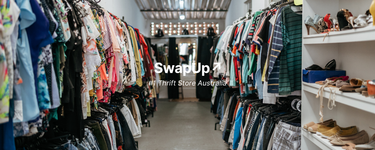Thrift stores have become increasingly popular across the world, including in Australia, thanks to the rise of sustainable fashion and budget-conscious shopping. Whether you’re on the hunt for a bargain, unique vintage pieces, or simply looking to give your pre-loved clothes a second life, thrift stores are a great option. But what exactly is a thrift store, how do they differ from other second-hand outlets, and can you actually sell your clothes to them? Let’s dive in.
What Is a Thrift Store?
A thrift store is a shop that sells second-hand clothing, accessories, household items, and sometimes furniture at affordable prices. Most thrift stores are run by charities or non-profit organisations, and the money raised goes towards funding community programs or social causes.
Because their stock is donated, you’ll often find a mix of everyday basics, vintage gems, and the occasional designer label—all at a fraction of the retail price.
Why Do Thrift Store Clothes Smell the Same?
If you’ve ever walked into a thrift store, you’ve probably noticed a distinct scent that seems to linger on most items. This is often due to:
-
Storage conditions: Clothes may have been kept in attics, basements, or warehouses before donation, where humidity and lack of ventilation cause a musty odour.
-
Cleaning methods: Many thrift stores bulk-wash donations using strong detergents or disinfectants, which create a uniform smell.
-
Age of garments: Older fabrics naturally hold onto odours more than newer ones.
The good news? A proper wash, a sunny line-dry, or a soak in vinegar or baking soda solution usually removes the smell.
Thrift Store vs Consignment Store
While both sell second-hand goods, there are key differences:
-
Thrift Store: Stock is usually donated, and profits go to charity. Donors don’t earn money for their items.
-
Consignment Store: Individuals give clothes to the store to sell on their behalf. Once sold, the consignor receives a percentage of the sale price, and the store keeps a commission.
In short: thrift stores are donation-driven, while consignment stores are profit-sharing.
Also read: The Difference Between Thrift Store & Consignment Store in Australia
Thrift Store vs Op Shop
In Australia, the term op shop (short for “opportunity shop”) is essentially the local version of a thrift store. Both terms refer to the same concept—charity-run shops selling donated goods. So if you see an op shop, you can think of it as the Australian equivalent of a thrift store.
Are There Thrift Stores in Australia?
Yes—Australia has a thriving op shop culture. Some of the most well-known chains include:
-
SwapUp (Australia’s online thrift store)
-
Vinnies (St Vincent de Paul Society)
-
Salvos Stores (The Salvation Army)
-
Red Cross Shops
-
Lifeline Shops
You’ll also find plenty of smaller community-run op shops and boutique-style thrift stores in suburbs and regional towns.
Are Thrift Stores Open on Sunday?
Opening hours vary by location, but many thrift stores and op shops in Australia do open on weekends, including Sundays. Larger city branches often keep extended hours, while smaller community shops may only trade on specific days. It’s best to check the local store’s hours online before visiting.
Can I Sell Clothes to a Thrift Store?
Most thrift stores do not buy clothes directly—they rely on donations. However, if you’re looking to make money from your pre-loved fashion, consignment stores or resale platforms are better options. That said, donating to thrift stores is a great way to declutter sustainably and support local charities.
How Much Do Thrift Stores Pay for Clothes?
Traditional thrift stores like Vinnies or Salvos usually do not pay for clothing, since they operate on donations. If your goal is to declutter and support a charity, these are excellent choices.
However, some consignment and resale platforms do pay for clothes. For example:
-
Consignment shops: Typically pay 30%–60% of the final sale price, depending on the brand and condition.
-
SwapUp: Makes it easy by handling the listing, photography, and shipping for you. Once your clothes sell, you receive either cash or store credit, with payouts varying based on the item’s resale value.
This means if you’re looking to earn back money from your wardrobe, resale options like SwapUp or boutique consignment stores are the better choice compared to traditional thrift stores.
Why Thrift Shopping Matters
Beyond affordability, thrift shopping plays a big role in sustainable fashion. By buying second-hand, you:
-
Reduce textile waste in landfills
-
Lower demand for fast fashion production
-
Give clothes a longer lifecycle
-
Support community causes
Final Thoughts
A thrift store—known as an op shop in Australia—is more than just a place to score cheap finds. It’s a hub for sustainable fashion, community support, and hidden treasures waiting to be discovered. Whether you’re donating, browsing, or hunting for vintage gems, thrift stores remain an essential part of Australia’s retail landscape.
Also read: Thrift stores: Why thrift shopping is good for your pocket & our planet




